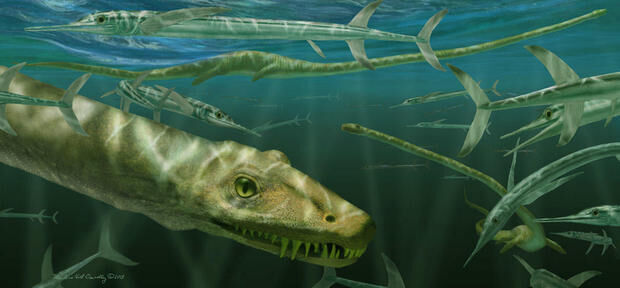
The 16-foot-long aquatic reptile, called Dinocephalosaurus orientalis, has 32 separate neck vertebrae - an extremely long neck, according to the National Museums of Scotland, which announced the news on Friday.
The new fossil has a snake-like appearance and flippers and was found in the Guizhou Province of southern China.

"It is yet one more example of the weird and wonderful world of the Triassic that continues to baffle palaeontologists. We are certain that it will capture imaginations across the globe due to its striking appearance, reminiscent of the long and snake-like, mythical Chinese Dragon," said Nick Fraser, keeper of Natural Sciences at National Museums Scotland.
This fossil, as well as two previously discovered embryos of a similar creature, have helped scientist learn more about this type of creature, according to the study, published by Cambridge University Press. They lived in water and likely didn't need to venture on land to lay eggs.
The largest discovered skull of a Dinocephalosaurus orientalis is about 9 inches and its largest preserved tooth is about an inch.
While the new fossil includes a poorly preserved skull, vertebrae, ribs and preserved limbs, the tail is missing. The vertebrae are "preserved in perfect articulation."
They also found at least four fish inside the abdomen, as well as small vertebrae and a possible limb bone, which could be an embryo or the remains of a small reptile the creature ate.
Researchers from the U.S., U.K., China and Europe have been studying this creature for 10 years. "Among all of the extraordinary finds we have made in the Triassic of Guizhou Province, Dinocephalosaurus probably stands out as the most remarkable," said Li Chun, a professor from the Institute of Vertebrate Palaeontology and Palaeoanthropology.
Caitlin O'Kane is a New York City journalist who works on the CBS News social media team as a senior manager of content and production. She writes about a variety of topics and produces The Uplift, CBS News' streaming show that focuses on good news.



A Chinese legend: how the dragon entered heaven. In olden times, the cockrel had horns. The dragon asked the cockrel to lend him his horns, in order to get into heaven. After much begging, the cockrel agreed, but only on condition that the dragon gave them back. The dragon agreed. The cockrel gave him his horns. The dragon left the Earth and went into heaven... and never came back. To this day, the cockrel has never forgotten the broken-promise of the dragon, and for that reason, the cockrel now screams at the sky every morning: "Where are my horns??"